Hoffman D.M., Singh B., Thomas J.H. (Eds). Handbook of Vacuum Science and Technology
Подождите немного. Документ загружается.

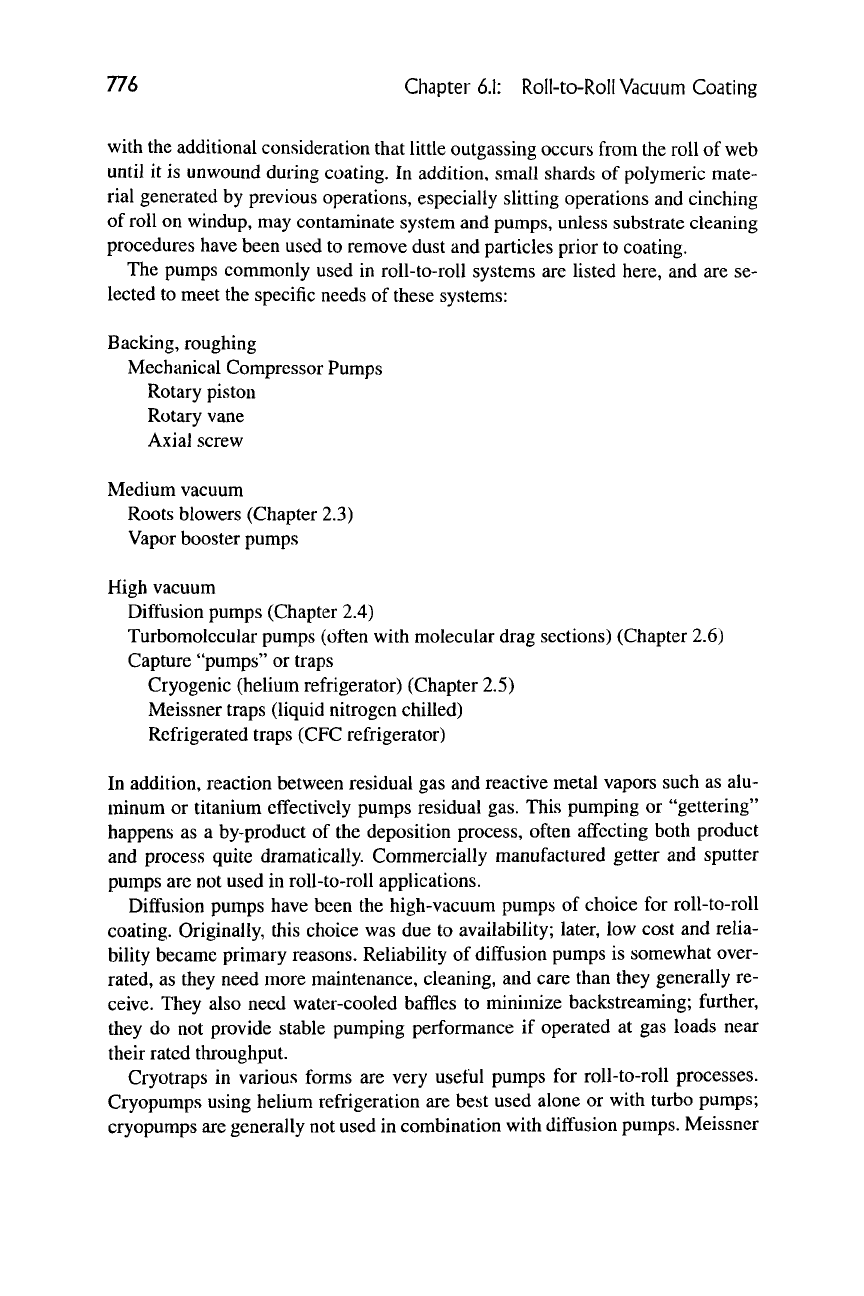
776 Chapter
6.1:
Roll-to-RoIl Vacuum Coating
with the additional consideration that little outgassing occurs from the roll of web
until it is unwound during coating. In addition, small shards of polymeric mate-
rial generated by previous operations, especially slitting operations and cinching
of roll on windup, may contaminate system and pumps, unless substrate cleaning
procedures have been used to remove dust and particles prior to coating.
The pumps commonly used in roll-to-roll systems are listed here, and are se-
lected to meet the specific needs of these systems:
Backing, roughing
Mechanical Compressor Pumps
Rotary piston
Rotary vane
Axial screw
Medium vacuum
Roots blowers (Chapter 2.3)
Vapor booster pumps
High vacuum
Diffusion pumps (Chapter 2.4)
Turbomolccular pumps (often with molecular drag sections) (Chapter 2.6)
Capture "pumps" or traps
Cryogenic (helium refrigerator) (Chapter 2.5)
Meissner traps (liquid nitrogen chilled)
Refrigerated traps (CFC refrigerator)
In addition, reaction between residual gas and reactive metal vapors such as alu-
minum or titanium effectively pumps residual gas. This pumping or "gettering"
happens as a by-product of the deposition process, often affecting both product
and process quite dramatically. Commercially manufactured getter and sputter
pumps are not used in roll-to-roll applications.
Diffusion pumps have been the high-vacuum pumps of choice for roll-to-roll
coating. Originally, this choice was due to availability; later, low cost and relia-
bility became primary reasons. Reliability of diffusion pumps is somewhat over-
rated, as they need more maintenance, cleaning, and care than they generally re-
ceive. They also need water-cooled baffles to minimize backstreaming; further,
they do not provide stable pumping performance if operated at gas loads near
their rated throughput.
Cryotraps in various forms are very useful pumps for roll-to-roll processes.
Cryopumps using helium refrigeration are best used alone or with turbo pumps;
cryopumps are generally not used in combination with diffusion pumps. Meissner
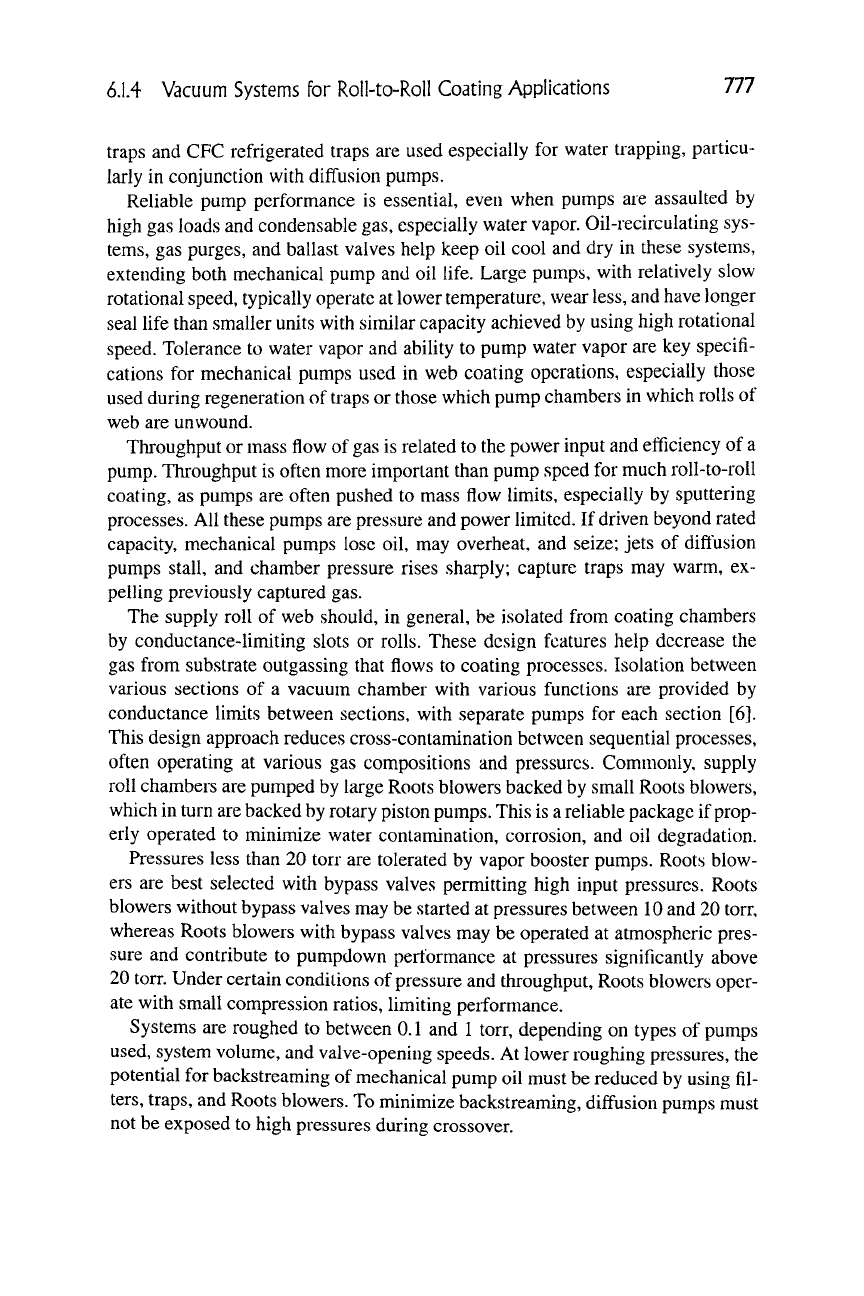
6.1.4 Vacuum Systems for Roll-to-Roll Coating Applications 777
traps and CFC refrigerated traps are used especially for water trapping, particu-
larly in conjunction with diffusion pumps.
Reliable pump performance is essential, even when pumps are assaulted by
high gas loads and condensable gas, especially water vapor. Oil-recirculating sys-
tems,
gas purges, and ballast valves help keep oil cool and dry in these systems,
extending both mechanical pump and oil life. Large pumps, with relatively slow
rotational speed, typically operate at lower temperature, wear
less,
and have longer
seal life than smaller units with similar capacity achieved by using high rotational
speed. Tolerance to water vapor and ability to pump water vapor are key specifi-
cations for mechanical pumps used in web coating operations, especially those
used during regeneration of traps or those which pump chambers in which rolls of
web are unwound.
Throughput or mass flow of gas is related to the power input and efficiency of a
pump. Throughput is often more important than pump speed for much roll-to-roll
coating, as pumps are often pushed to mass flow limits, especially by sputtering
processes. All these pumps are pressure and power limited. If driven beyond rated
capacity, mechanical pumps lose oil, may overheat, and seize; jets of diffusion
pumps stall, and chamber pressure rises sharply; capture traps may warm, ex-
pelling previously captured gas.
The supply roll of web should, in general, be isolated from coating chambers
by conductance-limiting slots or rolls. These design features help decrease the
gas from substrate outgassing that flows to coating processes. Isolation between
various sections of a vacuum chamber with various functions are provided by
conductance limits between sections, with separate pumps for each section [6].
This design approach reduces cross-contamination between sequential processes,
often operating at various gas compositions and pressures. Commonly, supply
roll chambers are pumped by large Roots blowers backed by small Roots blowers,
which in turn are backed by rotary piston pumps. This is
a
reliable package if
prop-
erly operated to minimize water contamination, corrosion, and oil degradation.
Pressures less than 20 torr are tolerated by vapor booster pumps. Roots blow-
ers are best selected with bypass valves permitting high input pressures. Roots
blowers without bypass valves may be started at pressures between 10 and 20 torr,
whereas Roots blowers with bypass valves may be operated at atmospheric pres-
sure and contribute to pumpdown performance at pressures significantly above
20 torr. Under certain conditions of pressure and throughput, Roots blowers oper-
ate with small compression ratios, limiting performance.
Systems are roughed to between 0.1 and 1 torr, depending on types of pumps
used, system volume, and valve-opening speeds. At lower roughing pressures, the
potential for backstreaming of mechanical pump oil must be reduced by using fil-
ters,
traps, and Roots blowers. To minimize backstreaming, diffusion pumps must
not be exposed to high pressures during crossover.
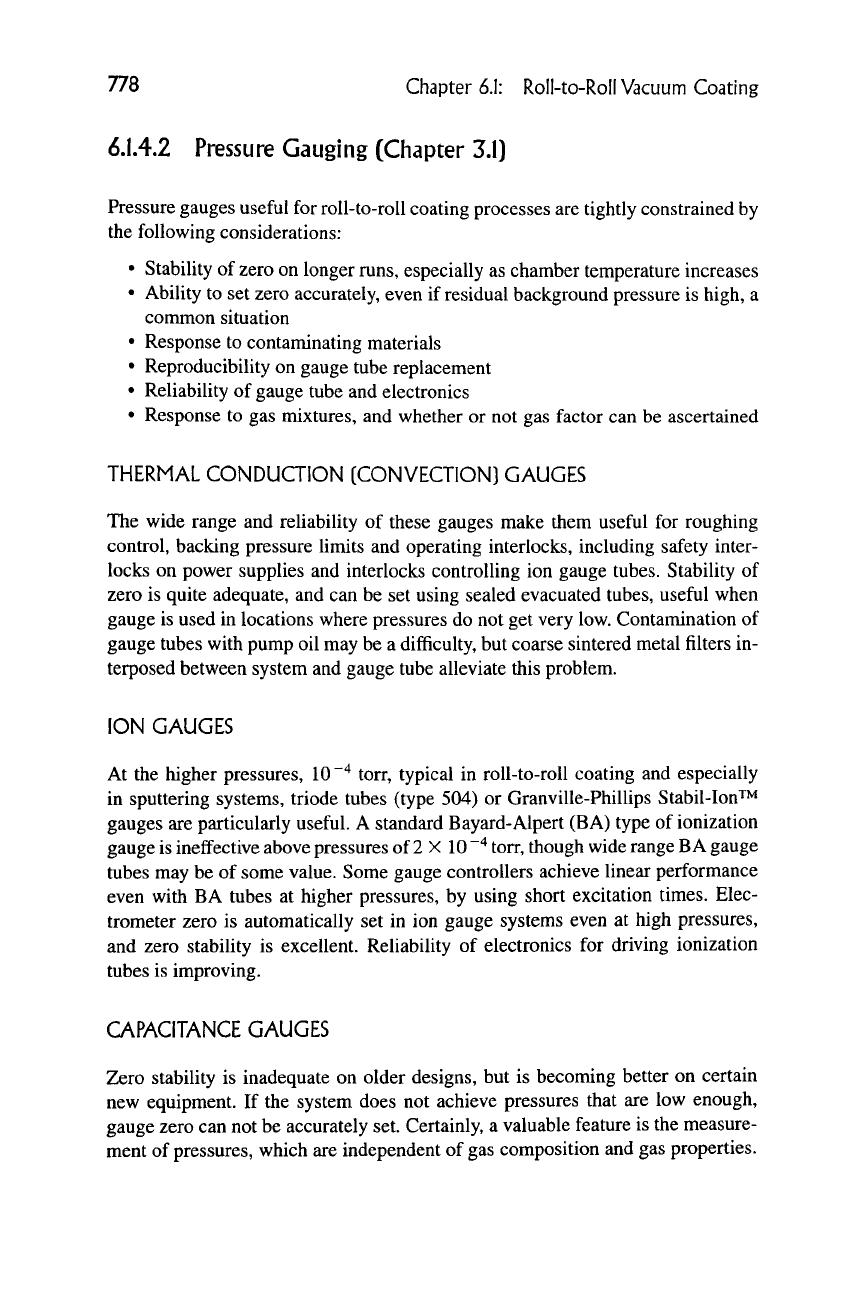
778 Chapter
6.1:
Roll-to-RoII
Vacuum
Coating
6.1.4.2 Pressure Gauging (Chapter 3.1)
Pressure gauges useful for roll-to-roll coating processes are tightly constrained by
the following considerations:
• Stability of zero on longer runs, especially as chamber temperature increases
• Ability to set zero accurately, even if residual background pressure is high, a
common situation
• Response to contaminating materials
• Reproducibility on gauge tube replacement
• Reliability of gauge tube and electronics
• Response to gas mixtures, and whether or not gas factor can be ascertained
THERMAL CONDUCTION [CONVECTION) GAUGES
The wide range and reliability of these gauges make them useful for roughing
control, backing pressure limits and operating interlocks, including safety inter-
locks on power supplies and interlocks controlling ion gauge tubes. Stability of
zero is quite adequate, and can be set using sealed evacuated tubes, useful when
gauge is used in locations where pressures do not get very low. Contamination of
gauge tubes with pump oil may be a difficulty, but coarse sintered metal filters in-
terposed between system and gauge tube alleviate this problem.
ION GAUGES
At the higher pressures,
10 ""^
torr, typical in roll-to-roll coating and especially
in sputtering systems, triode tubes (type 504) or Granville-Phillips Stabil-Ion^^
gauges are particularly useful. A standard Bayard-Alpert (BA) type of ionization
gauge is ineffective above pressures of 2 X
10 ""^
torr, though wide range BA gauge
tubes may be of some value. Some gauge controllers achieve linear performance
even with BA tubes at higher pressures, by using short excitation times. Elec-
trometer zero is automatically set in ion gauge systems even at high pressures,
and zero stability is excellent. Reliability of electronics for driving ionization
tubes is improving.
CAPACITANCE GAUGES
Zero stability is inadequate on older designs, but is becoming better on certain
new equipment. If the system does not achieve pressures that are low enough,
gauge zero can not be accurately set. Certainly, a valuable feature is the measure-
ment of pressures, which are independent of gas composition and gas properties.

6.1.5 Substrates [Webs]
779
6.1.5
SUBSTRATES (WEBS)
6.1.5.1
Web Materials
Polymers (see expanded discussion at end of list)
Polyester (Polyethylencterepthalate) (PET) is the workhorse of this industry
and is readily available in thicknesses from 1.5 to 175 /im, 0.00006-
0.007
inch.
Polyimide (Kapton^M) is used for flexible circuits. This material tolerates
very high temperature, so products made using it are solderable.
Poly amide (Nylon
T^)
Polymethylmethacrylate (Plexiglas^M, Lucite^M)
Polycarbonate (Lexan^^)
Polyethylenenapthalate
Polyethylene
Polypropylene
Polytetrafluoroethylene (Teflon ^^)
Polystyrene
Cellulose acetate
Polyvinylidene Chloride (Saran^^^
Metal foils
Paper products
Kraft and standard papers
Textiles
Woven and felts or nonwovens of natural fibers and synthetic fibers, including
glass fibers
In addition to the wide variety of polymers just listed, there are copolymers, poly-
mer blends, block copolymers, coextrusions, layered, and laminated materials.
Many processing variables determine internal structure and therefore properties
and performance of each polymer system.
As an example, polyester (PET) can have a range of thermal expansion, hygro-
scopic expansion, shrinkage on heating, modulus, and level of trimers. The value
of each of these properties depends on the amount of stretch during orientation,
on temperature and time of heat setting, all of which result in different amounts of
crystallinity. Stretch is a factor that is typically different in the longitudinal direc-
tion of the web (machine direction) from the cross-web direction (transverse di-
rection), creating properties that are anisotropic.
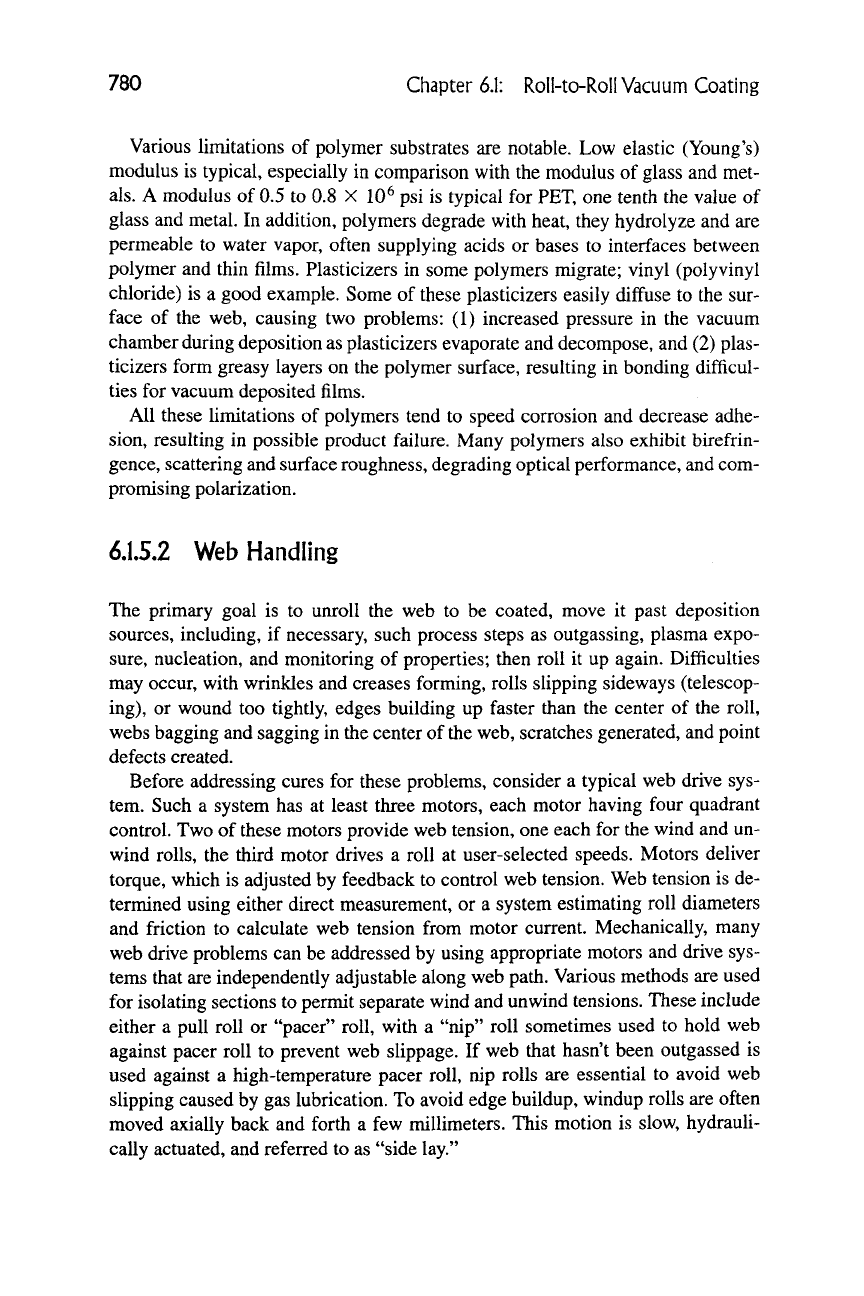
780 Chapter 6.1: Roll-to-Roll Vacuum Coating
Various limitations of polymer substrates are notable. Low elastic (Young's)
modulus is typical, especially in comparison with the modulus of glass and met-
als.
A modulus of 0.5 to 0.8 X 10^ psi is typical for PET, one tenth the value of
glass and metal. In addition, polymers degrade with heat, they hydrolyze and are
permeable to water vapor, often supplying acids or bases to interfaces between
polymer and thin films. Plasticizers in some polymers migrate; vinyl (polyvinyl
chloride) is a good example. Some of these plasticizers easily diffuse to the sur-
face of the web, causing two problems: (1) increased pressure in the vacuum
chamber during deposition as plasticizers evaporate and decompose, and (2) plas-
ticizers form greasy layers on the polymer surface, resulting in bonding difficul-
ties for vacuum deposited films.
All these limitations of polymers tend to speed corrosion and decrease adhe-
sion, resulting in possible product failure. Many polymers also exhibit birefrin-
gence, scattering and surface roughness, degrading optical performance, and com-
promising polarization.
6.1.5.2 Web Handling
The primary goal is to unroll the web to be coated, move it past deposition
sources, including, if necessary, such process steps as outgassing, plasma expo-
sure,
nucleation, and monitoring of properties; then roll it up again. Difficulties
may occur, with wrinkles and creases forming, rolls slipping sideways (telescop-
ing),
or wound too tightly, edges building up faster than the center of the roll,
webs bagging and sagging in the center of the web, scratches generated, and point
defects created.
Before addressing cures for these problems, consider a typical web drive sys-
tem. Such a system has at least three motors, each motor having four quadrant
control. Two of these motors provide web tension, one each for the wind and un-
wind rolls, the third motor drives a roll at user-selected speeds. Motors deliver
torque, which is adjusted by feedback to control web tension. Web tension is de-
termined using either direct measurement, or a system estimating roll diameters
and friction to calculate web tension from motor current. Mechanically, many
web drive problems can be addressed by using appropriate motors and drive sys-
tems that are independently adjustable along web path. Various methods are used
for isolating sections to permit separate wind and unwind tensions. These include
either a pull roll or "pacer" roll, with a "nip" roll sometimes used to hold web
against pacer roll to prevent web slippage. If web that hasn't been outgassed is
used against a high-temperature pacer roll, nip rolls are essential to avoid web
slipping caused by gas lubrication. To avoid edge buildup, windup rolls are often
moved axially back and forth a few millimeters. This motion is slow, hydrauli-
cally actuated, and referred to as "side lay."
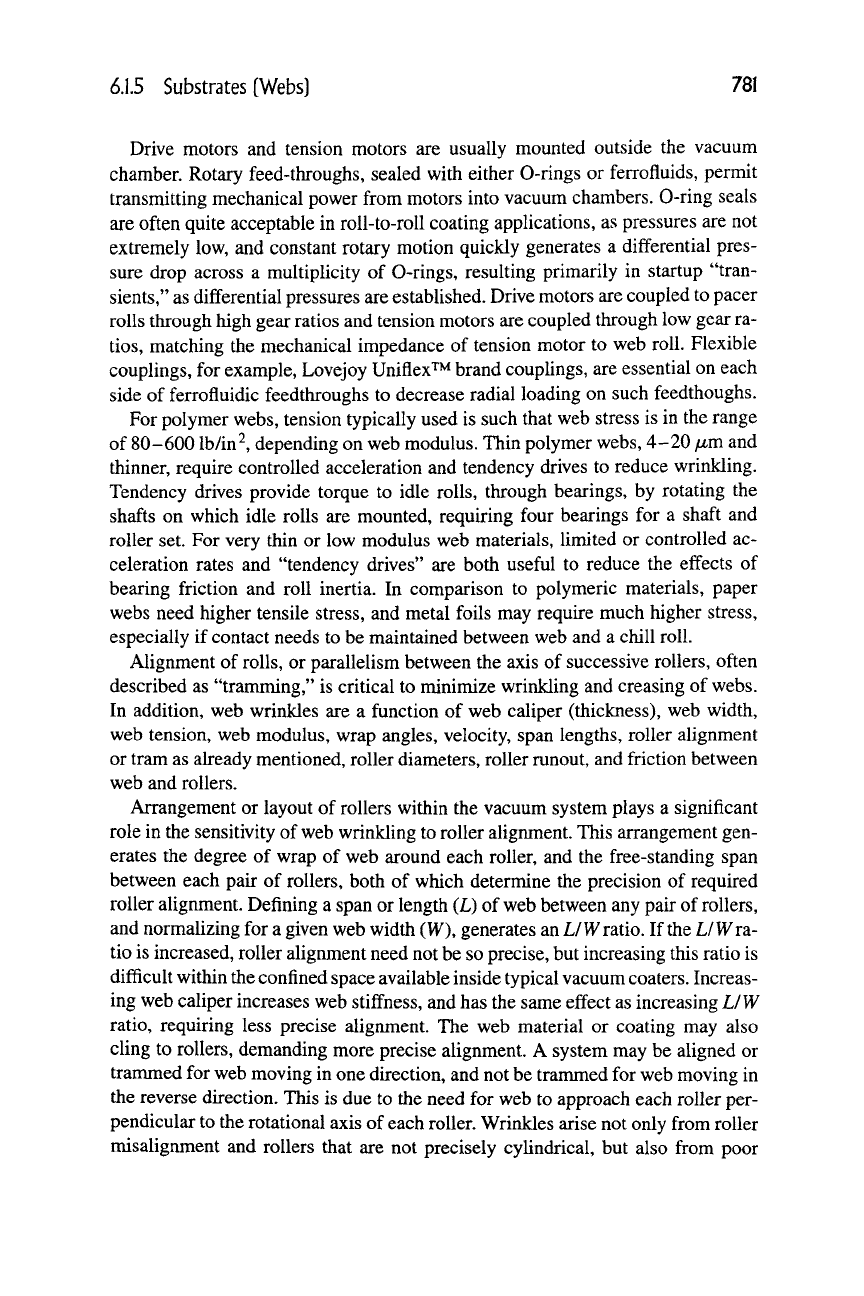
6.1.5
Substrates [Webs]
781
Drive motors and tension motors are usually mounted outside the vacuum
chamber. Rotary feed-throughs, sealed with either 0-rings or ferrofluids, permit
transmitting mechanical power from motors into vacuum chambers. 0-ring seals
are often quite acceptable in roll-to-roll coating applications, as pressures are not
extremely low, and constant rotary motion quickly generates a differential pres-
sure drop across a multiplicity of 0-rings, resulting primarily in startup "tran-
sients,"
as differential pressures are established. Drive motors are coupled to pacer
rolls through high gear ratios and tension motors are coupled through low gear ra-
tios,
matching the mechanical impedance of tension motor to web roll. Flexible
couplings, for example, Lovejoy Uniflex^^ brand couplings, are essential on each
side of ferrofluidic feedthroughs to decrease radial loading on such feedthoughs.
For polymer webs, tension typically used is such that web stress is in the range
of 80-600 lb/in^, depending on web modulus. Thin polymer webs, 4-20
jmrn
and
thinner, require controlled acceleration and tendency drives to reduce wrinkling.
Tendency drives provide torque to idle rolls, through bearings, by rotating the
shafts on which idle rolls are mounted, requiring four bearings for a shaft and
roller set. For very thin or low modulus web materials, limited or controlled ac-
celeration rates and "tendency drives" are both useful to reduce the effects of
bearing friction and roll inertia. In comparison to polymeric materials, paper
webs need higher tensile stress, and metal foils may require much higher stress,
especially if contact needs to be maintained between web and a chill roll.
Alignment of rolls, or parallelism between the axis of successive rollers, often
described as "tramming," is critical to minimize wrinkling and creasing of webs.
In addition, web wrinkles are a function of web caliper (thickness), web width,
web tension, web modulus, wrap angles, velocity, span lengths, roller alignment
or tram as already mentioned, roller diameters, roller runout, and friction between
web and rollers.
Arrangement or layout of rollers within the vacuum system plays a significant
role in the sensitivity of
web
wrinkling to roller alignment. This arrangement gen-
erates the degree of wrap of web around each roller, and the free-standing span
between each pair of rollers, both of which determine the precision of required
roller alignment. Defining a span or length (L) of web between any pair of rollers,
and normalizing for a given web width (W), generates an L/Wiaiio. If
the
L/Vi^ra-
tio is increased, roller alignment need not be so precise, but increasing this ratio is
difficult within the confined space available inside typical vacuum
coaters.
Increas-
ing web caliper increases web stiffness, and has the same effect as increasing L/W
ratio,
requiring less precise alignment. The web material or coating may also
cling to rollers, demanding more precise alignment. A system may be aligned or
tranuned for web moving in one direction, and not be tranuned for web moving in
the reverse direction. This is due to the need for web to approach each roller per-
pendicular to the rotational axis of each roller. Wrinkles arise not only from roller
misalignment and rollers that are not precisely cylindrical, but also from poor
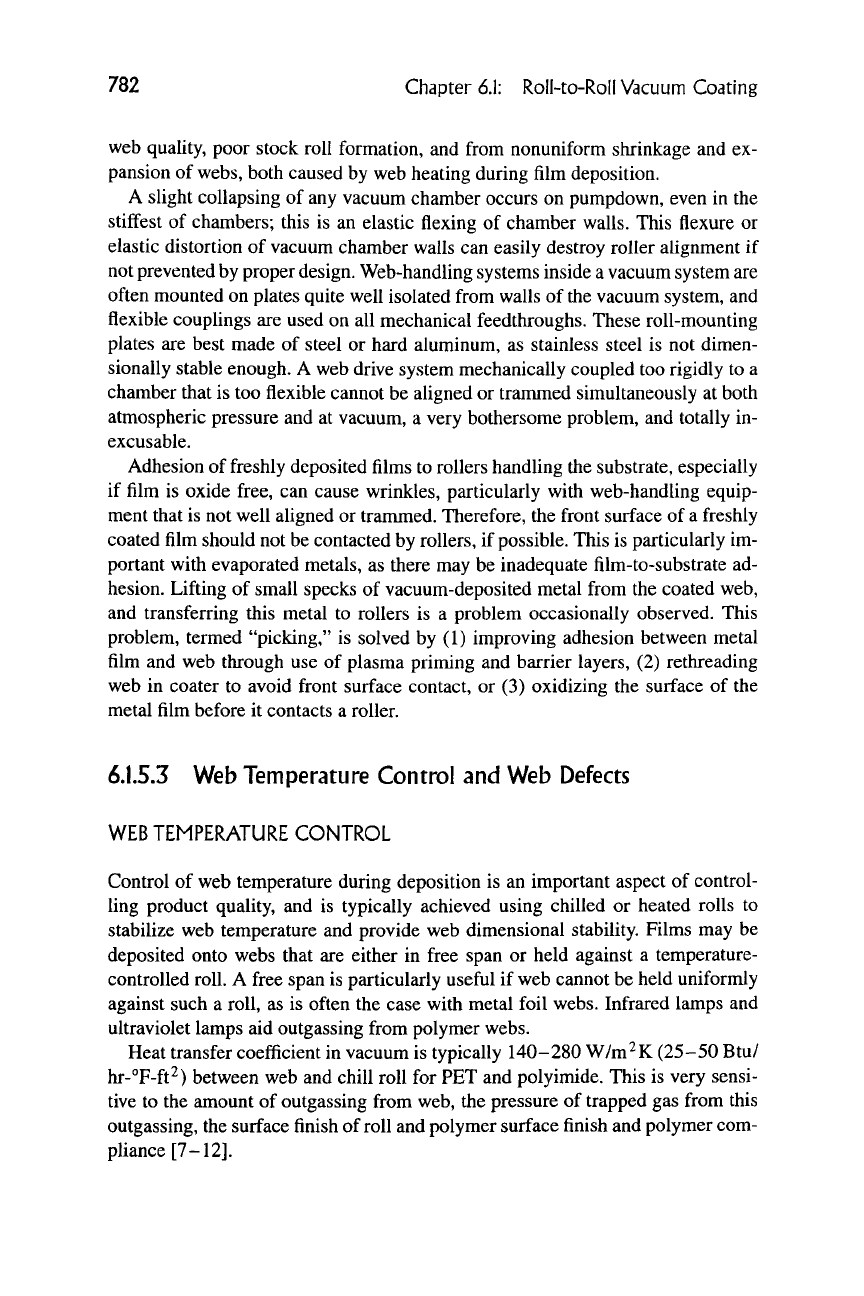
782 Chapter
6.1:
RolI-to-Roll Vacuum Coating
web quality, poor stock roll formation, and from nonuniform shrinkage and ex-
pansion of webs, both caused by web heating during film deposition.
A slight collapsing of any vacuum chamber occurs on pumpdown, even in the
stiffest of chambers; this is an elastic flexing of chamber walls. This flexure or
elastic distortion of vacuum chamber walls can easily destroy roller alignment if
not prevented by proper design. Web-handling systems inside a vacuum system are
often mounted on plates quite well isolated from walls of the vacuum system, and
flexible couplings are used on all mechanical feedthroughs. These roll-mounting
plates are best made of steel or hard aluminum, as stainless steel is not dimen-
sionally stable enough. A web drive system mechanically coupled too rigidly to a
chamber that is too flexible cannot be aligned or trammed simultaneously at both
atmospheric pressure and at vacuum, a very bothersome problem, and totally in-
excusable.
Adhesion of freshly deposited films to rollers handling the substrate, especially
if film is oxide free, can cause wrinkles, particularly with web-handling equip-
ment that is not well aligned or trammed. Therefore, the front surface of a freshly
coated film should not be contacted by rollers, if
possible.
This is particularly im-
portant with evaporated metals, as there may be inadequate film-to-substrate ad-
hesion. Lifting of small specks of vacuum-deposited metal from the coated web,
and transferring this metal to rollers is a problem occasionally observed. This
problem, termed "picking," is solved by (1) improving adhesion between metal
film and web through use of plasma priming and barrier layers, (2) rethreading
web in coater to avoid front surface contact, or (3) oxidizing the surface of the
metal film before it contacts a roller.
6.1.5.3 Web Temperature Control and Web Defects
WEB TEMPERATURE CONTROL
Control of web temperature during deposition is an important aspect of control-
ling product quality, and is typically achieved using chilled or heated rolls to
stabilize web temperature and provide web dimensional stability. Films may be
deposited onto webs that are either in free span or held against a temperature-
controlled roll. A free span is particularly useful if web cannot be held uniformly
against such a roll, as is often the case with metal foil webs. Infrared lamps and
ultraviolet lamps aid outgassing from polymer webs.
Heat transfer coefficient in vacuum is typically 140-280 W/m^K (25-50 Btu/
hr-°F-ft^) between web and chill roll for PET and polyimide. This is very sensi-
tive to the amount of outgassing from web, the pressure of trapped gas from this
outgassing, the surface finish of roll and polymer surface finish and polymer com-
pliance
[7-12].
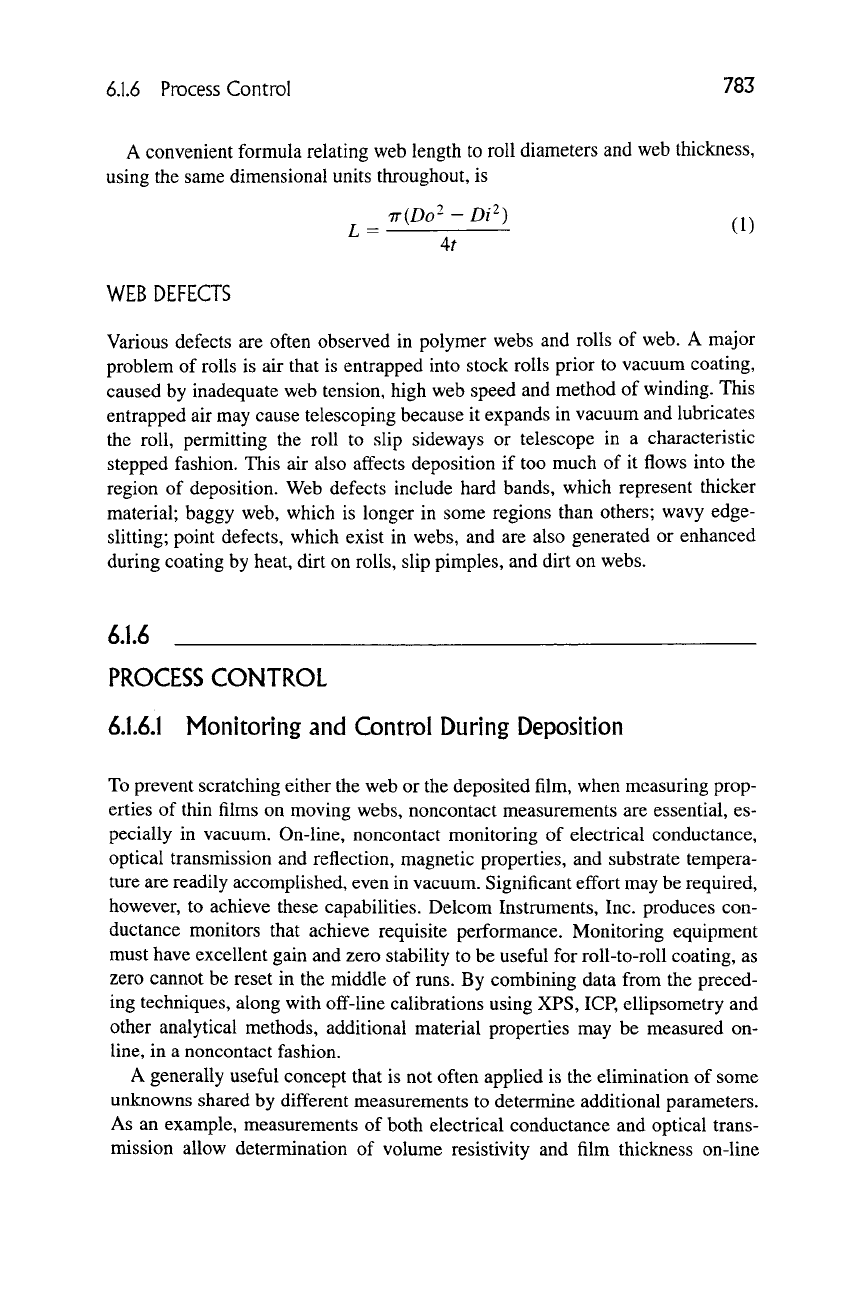
6.1.6 Process Control
783
A convenient formula relating web length to roll diameters and web thickness,
using the same dimensional units throughout, is
At
WEB DEFECTS
Various defects are often observed in polymer webs and rolls of web. A major
problem of rolls is air that is entrapped into stock rolls prior to vacuum coating,
caused by inadequate web tension, high web speed and method of winding. This
entrapped air may cause telescoping because it expands in vacuum and lubricates
the roll, permitting the roll to slip sideways or telescope in a characteristic
stepped fashion. This air also affects deposition if too much of it flows into the
region of deposition. Web defects include hard bands, which represent thicker
material; baggy web, which is longer in some regions than others; wavy edge-
slitting; point defects, which exist in webs, and are also generated or enhanced
during coating by heat, dirt on rolls, slip pimples, and dirt on webs.
6.1.6
PROCESS CONTROL
6.1.6.1 Monitoring and Control During Deposition
To prevent scratching either the web or the deposited film, when measuring prop-
erties of thin films on moving webs, noncontact measurements are essential, es-
pecially in vacuum. On-line, noncontact monitoring of electrical conductance,
optical transmission and reflection, magnetic properties, and substrate tempera-
ture are readily accomplished, even in vacuum. Significant effort may be required,
however, to achieve these capabilities. Delcom Instruments, Inc. produces con-
ductance monitors that achieve requisite performance. Monitoring equipment
must have excellent gain and zero stability to be useful for roll-to-roll coating, as
zero cannot be reset in the middle of runs. By combining data from the preced-
ing techniques, along with off-line calibrations using XPS, ICP, ellipsometry and
other analytical methods, additional material properties may be measured on-
line,
in a noncontact fashion.
A generally useful concept that is not often applied is the elimination of some
unknowns shared by different measurements to determine additional parameters.
As an example, measurements of both electrical conductance and optical trans-
mission allow determination of volume resistivity and film thickness on-line
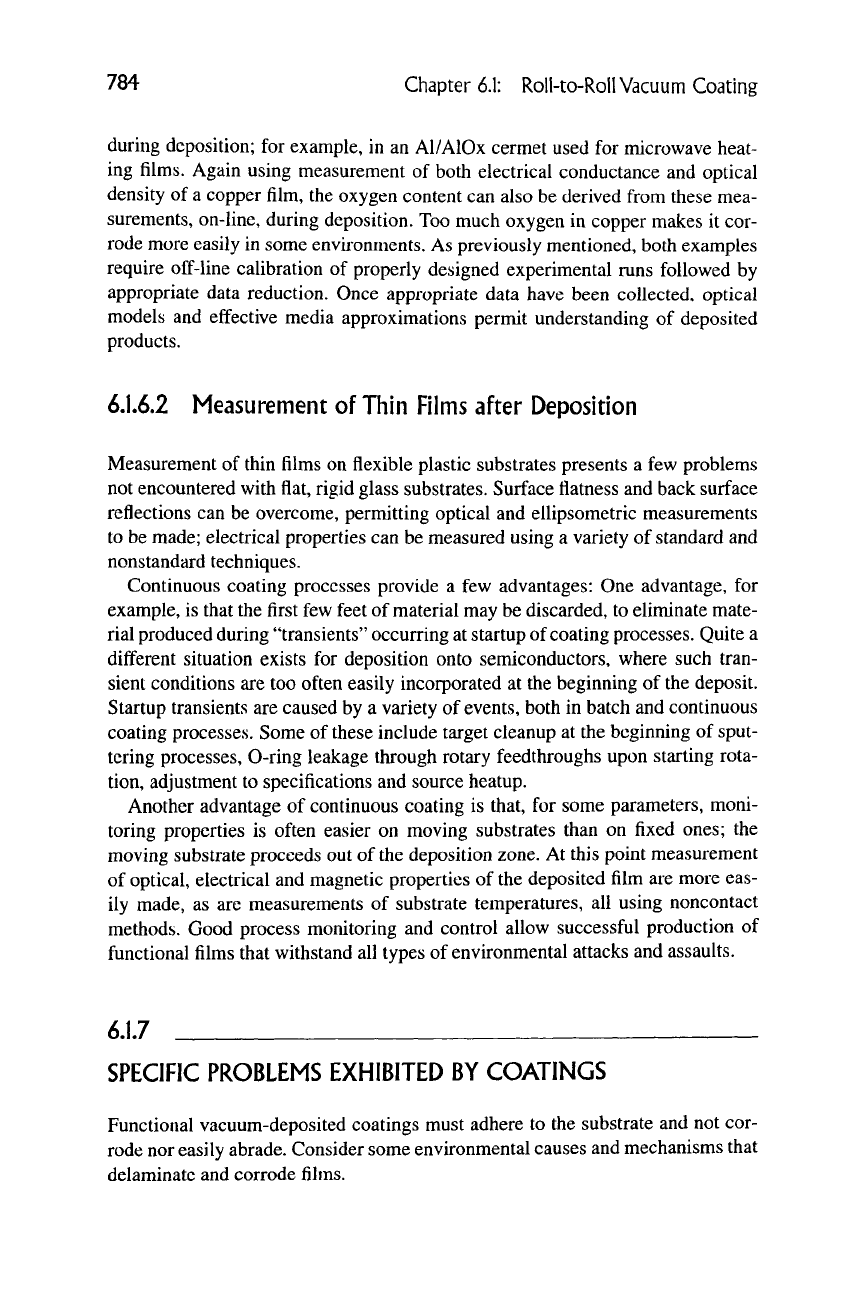
784 Chapter
6.1:
RolI-to-RoII Vacuum
Coating
during deposition; for example, in an Al/AlOx cermet used for microwave heat-
ing films. Again using measurement of both electrical conductance and optical
density of a copper film, the oxygen content can also be derived from these mea-
surements, on-line, during deposition. Too much oxygen in copper makes it cor-
rode more easily in some environments. As previously mentioned, both examples
require off-line calibration of properly designed experimental runs followed by
appropriate data reduction. Once appropriate data have been collected, optical
models and effective media approximations permit understanding of deposited
products.
6.1.6.2 Measurement of Thin Films after Deposition
Measurement of thin films on flexible plastic substrates presents a few problems
not encountered with flat, rigid glass substrates. Surface flatness and back surface
reflections can be overcome, permitting optical and ellipsometric measurements
to be made; electrical properties can be measured using a variety of standard and
nonstandard techniques.
Continuous coating processes provide a few advantages: One advantage, for
example, is that the first few feet of material may be discarded, to eliminate mate-
rial produced during "transients" occurring at startup of coating processes. Quite a
different situation exists for deposition onto semiconductors, where such tran-
sient conditions are too often easily incorporated at the beginning of the deposit.
Startup transients are caused by a variety of events, both in batch and continuous
coating processes. Some of these include target cleanup at the beginning of sput-
tering processes, 0-ring leakage through rotary feedthroughs upon starting rota-
tion, adjustment to specifications and source heatup.
Another advantage of continuous coating is that, for some parameters, moni-
toring properties is often easier on moving substrates than on fixed ones; the
moving substrate proceeds out of the deposition zone. At this point measurement
of optical, electrical and magnetic properties of the deposited film are more eas-
ily made, as are measurements of substrate temperatures, all using noncontact
methods. Good process monitoring and control allow successful production of
functional films that withstand all types of environmental attacks and assaults.
6.1.7
SPECIFIC PROBLEMS EXHIBITED BY COATINGS
Functional vacuum-deposited coatings must adhere to the substrate and not cor-
rode nor easily abrade. Consider some environmental causes and mechanisms that
delaminate and corrode films.
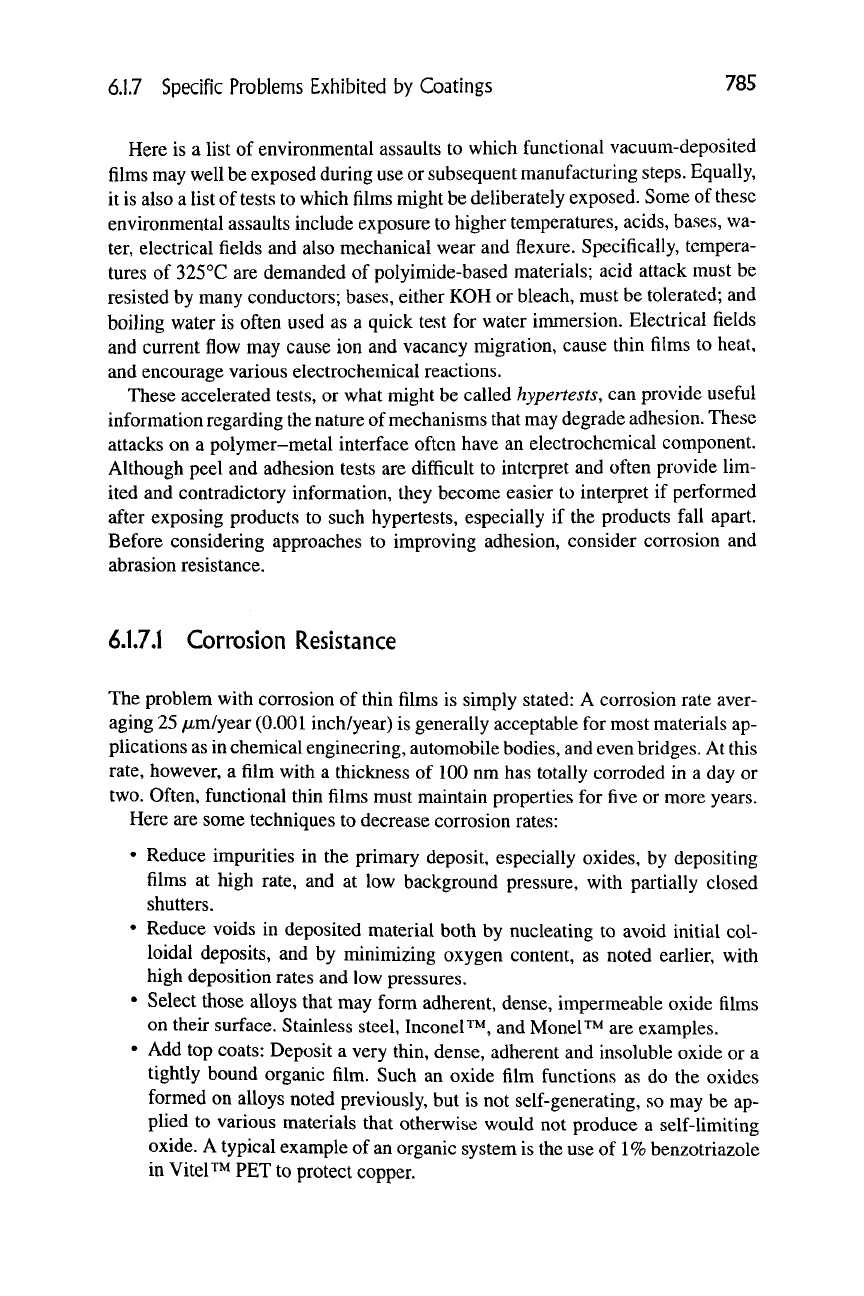
6.1.7 Specific Problems Exhibited by Coatings 785
Here is a list of environmental assaults to which functional vacuum-deposited
films may well be exposed during use or subsequent manufacturing steps. Equally,
it is also a list of
tests
to which films might be deliberately exposed. Some of these
environmental assaults include exposure to higher temperatures, acids, bases, wa-
ter, electrical fields and also mechanical wear and flexure. Specifically, tempera-
tures of 325°C are demanded of polyimide-based materials; acid attack must be
resisted by many conductors; bases, either KOH or bleach, must be tolerated; and
boiling water is often used as a quick test for water immersion. Electrical fields
and current flow may cause ion and vacancy migration, cause thin films to heat,
and encourage various electrochemical reactions.
These accelerated tests, or what might be called hypertests, can provide useful
information regarding the nature of mechanisms that may degrade adhesion. These
attacks on a polymer-metal interface often have an electrochemical component.
Although peel and adhesion tests are difficult to interpret and often provide lim-
ited and contradictory information, they become easier to interpret if performed
after exposing products to such hypertests, especially if the products fall apart.
Before considering approaches to improving adhesion, consider corrosion and
abrasion resistance.
6.1.7.1 Corrosion Resistance
The problem with corrosion of thin films is simply stated: A corrosion rate aver-
aging 25 /im/year
(0.001
inch/year) is generally acceptable for most materials ap-
plications as in chemical engineering, automobile
bodies,
and even
bridges.
At this
rate,
however, a film with a thickness of 100 nm has totally corroded in a day or
two.
Often, functional thin films must maintain properties for five or more years.
Here are some techniques to decrease corrosion rates:
• Reduce impurities in the primary deposit, especially oxides, by depositing
films at high rate, and at low background pressure, with partially closed
shutters.
• Reduce voids in deposited material both by nucleating to avoid initial col-
loidal deposits, and by minimizing oxygen content, as noted earlier, with
high deposition rates and low pressures.
• Select those alloys that may form adherent, dense, impermeable oxide films
on their surface. Stainless steel, InconeP^, and MoneF^ are examples.
• Add top coats: Deposit a very thin, dense, adherent and insoluble oxide or a
tightly bound organic film. Such an oxide film functions as do the oxides
formed on alloys noted previously, but is not self-generating, so may be ap-
plied to various materials that otherwise would not produce a self-Umiting
oxide. A typical example of an organic system is the use of 1% benzotriazole
in ViteFM PET to protect copper.
